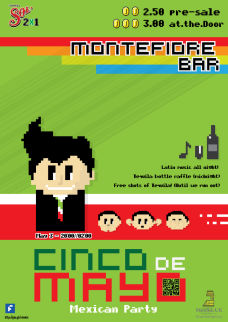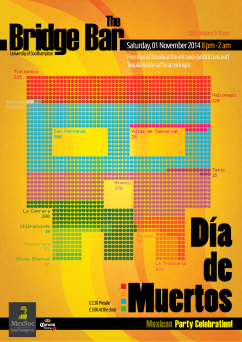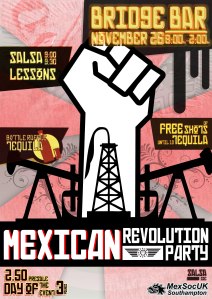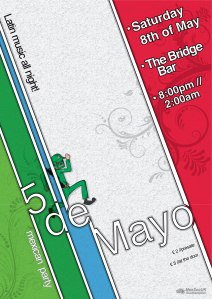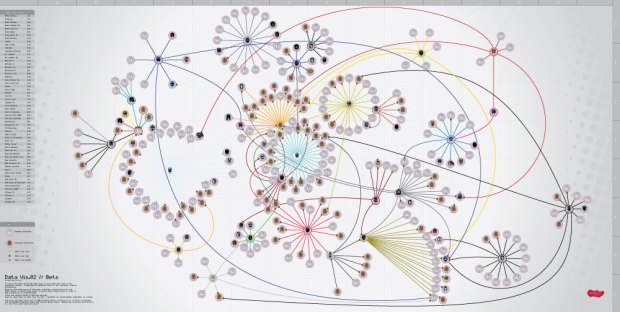Part 02. Layout and Design Issues
Layout.
There is going to be several ways to arrange and layout the content of our poster, but there is going to be several key elements that we don’t want to look over before making any decisions of where to place our objects.

By default at least in non-Oriental cultures, we will start reading from left to right and then from top to bottom. That is why we have to be very clear the way we arrange our elements and the spacing between them.
In this example on the left we can see how a simple landscape page can be divided into four quadrants, showing us the reading sequence of our audience. This means that the first area in where our audience will look for information will be the quadrant no.1
Now that we know that the audience will start on the top-left of the page, then we can start to sub-divide our content depending on the amount of information and type of imagery to be used.

The illustration on the right shows us that now we have two main elements: The Title placed on the top left ant the rest of our quadrants placed right after the title, allowing us now to subdivide the rest of the page into sections, which will be containing the rest of our elements..
When we start defining the positions of the elements on our poster, remember to be creative! Perhaps you want to start by sketching some ideas or placements of your elements before you even start creating the layout or placing the elements on the canvas.
Remember we already had placed the title on the top.
Grid for the Layout.
The grid can become a very helpful ally that will guide us to divide the spaces of our canvas, that way all we have to do is place the elements on the cells of our grid.
The first thing we have to do is to start sub-dividing on a continuous division of the canvas in the ratio 1:1414. Using our canvas as a guide, we can maintain the proportion throughout the grid, this will give our design elements a relationship towards the paper size and the grid. By using the size of the paper as a guide we can divide using that ratio to begin creating the grid.
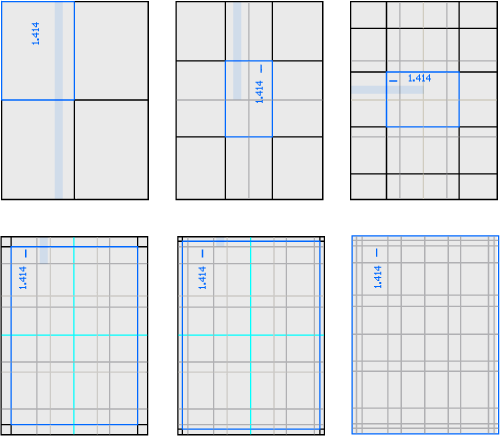
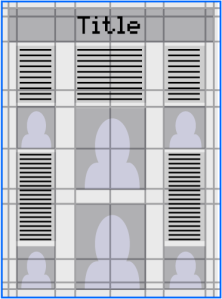
Placing the elements.
At this moment we have divided our canvas into several cells and columns. Now is the time for us to start placing our elements. At first, looking at the grid, it seems quite contradictory to have creativity on what it seems to be such a rigid layout. The grid systems will help by providing a framework and recommended positions for our elements. Remember at any moment you can sub-divide even further any of the areas of the grid that you already have. Experiment with your elements but keep in mind the sequence for your information.
Approximate size: 1m X 1m
Number of parts: 10 maximum
Lines per part: 10 – 20 maximum
Typography.
Type is one of the most important elements, not only for the final aesthetic result but also to provide the a better accessibility to the information.
There are two main concerns related to type:
Readability is the result of the complete process of presentation of the text material in order to communicate the message clearly. Readability will relate to a whole paragraph or sentence, a text as a whole and its accessibility
Legibility focuses on each individual character or glyph making sure it is distinguishable from all other characters in the font. Legibility is including on the design process in which we pick the appropriate typography that is not only easy to read or to identify, but also that contains the personality that we are looking for.
We have to take these two concepts into consideration while we are introducing type to our poster, since there are going to be several elements that will affect either the readability or the legibility of our text.

Avoid using serif fonts for the title, but is recommended to use them on the main body of your text.
Do not use bullets on your main headers, use bold type and follow a proper hierarchical sequence for headers and sub-headers.
The width of the text boxes should be approximately 40 characters, having on average 11 words per line.
Avoid blocks of text longer than 10 sentences.
Do not underline, use italics instead.
Avoid using dark backgrounds or element saturated backgrounds.
Recommended fonts:
Titles: Helvetica, Arial, etc..
Body of text: Times New Roman, Palatino, etc…
Sizing, it is recommended to use the font size to 40pts. This is because we have some considerations towards the audience:
Poster reading time: 2 minutes
Distance to be read: >2 meters
Colour.
Although colour can enhance the content of our elements, it can also work against us. We have to be aware which combination of colours we are going to be using so we won’t affect either the legibility or readability of our text content and make it friendly and appealing to our audience at the same time.
We already have some typography based restrictions for the colour. Now, we will get more into detail to check what are going to be our best options.
Contrast.
In typography, colour contrast its what is going to make it stand out. Here are some examples and recommendations for the colour contrast:

This is an example of how colour contrast is used to stand out text. Red text over the white background jumps out from the screen straight away, meanwhile the dark colour sits more quietly enclosing the whole concept.
Using white or a light colour is easier to deal with, since it is a very noble or friendly color, which allows us to combine it easily.
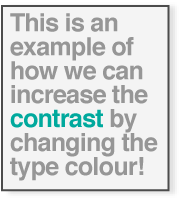
Another option would be by changing the colour of the type. This will allow also some words to stand out, without disturbing the rest of the content. Although we will be using a colour change on the type, it is recomended to continue with a simple pattern or stick to the color swatch that we will define for the poster.
After these examples we can start experimenting a little bit more and perhaps use colour and contrast to enhance the visual appeal of our text or titles by using our basic colours from our colour swatch defined for our poster.

Choosing the colour palette.
There are several tools that we can use to pick the basic colour paletes or swatch collections for our designs. But firs of all lets understand which colours will work best for our readability and legibility according to how they relate or how much contrast they generate in between them.
The first thing we need to do when we picking a colour palette is to define a theme. This theme of course has to have a personality, which at the same time is directly related to a colour. We will pick that colour and then apply the several colour combination rules, which are:
- Analoguous
- Monochromatic
- Triad
- Complementary
- Compound
- Shades
Lets imagine we will be presenting a poster related to the ocean. As we know on a big scale the most predominant colour is blue. Now, lets use that colour and start applying some combination rules…
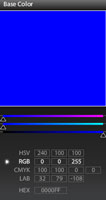


There is an free web application created by Adobe called Kuler. This application is also in Photoshop CS4. What this application does is to help us to device colour schemes through the several color theory rules.
If you load the Adobe Kuler application, go to Create – From a Color and then pick the base colour.
We will start by picking the blue colour, wich contains 100%Cyan, 100%Magenta, 0%Yellow and 0%Black. Now all we have to do is to pick the rule that we want to apply. Make sure once you pick a rule to apply as your colour scheme, don’t start combining other color into the main colour scheme of your design.
On the bottom of the colour swatch, you will be able to see the RGB, CMYK, HSV, Hex and LAB colour values, so you can be able to apply this colours properly if you need to present your poster as a digital version on the web or any other digital media output.
Analogue Rule.

Monochromatic Rule.

Triad Rule.

Complementary.

Compound.

Shades.



Part 01 – Basic Concepts (Scientific Poster)

Bibliography.
Block, S. 1996. The DOs and DON’Ts of poster presentation. Biophysical Journal 71:3527-3529
Briscoe, M.H. 1996. Preparing Scientific Illustrations: A Guide to Better Posters, Presentations, and Publications, 2nd ed. Springer-Verlag, New York
Advice on designing scientific posters. Colin Purrington, Department of Biology, Swarthmore College, Pennsylvania
Alley, Michael, The Craft of Scientific Presentations (New York: Springer-Verlag, 2003), pp. 211-217.
http://www.writing.engr.psu.edu/posters.html
La alegría de publicar 3. Las presentaciones de carteles en congresos científicos. Carlos Alfonso Reyes, M.D.1, Guillermo Llanos, M.D
Five simple steps to designing grid systems, Mark Boulton
Recomendaciones en la elaboración de un cartel.
Color and Typography in Good Desing, ColourLovers.
Requisitos Para Carteles. UAM, Mexico
Readability Test, Juicy Studio.



